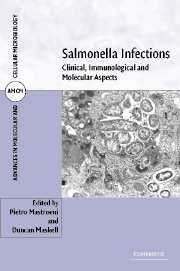Book contents
- Frontmatter
- Contents
- List of contributors
- Preface
- 1 Epidemiological and clinical aspects of human typhoid fever
- 2 Antibiotic resistance in Salmonella infections
- 3 Host-specificity of Salmonella infections in animal species
- 4 Public health aspects of Salmonella enterica in food production
- 5 The Salmonella genome: a global view
- 6 Pathogenicity islands and virulence of Salmonella enterica
- 7 In vivo identification, expression and function of Salmonella virulence genes
- 8 Mechanisms of immunity to Salmonella infections
- 9 Interactions of S. enterica with phagocytic cells
- 10 Interactions between Salmonella and dendritic cells: what happens along the way?
- 11 Immunity to Salmonella in domestic (food animal) species
- 12 Newer vaccines against typhoid fever and gastrointestinal salmonelloses
- 13 S. enterica-based antigen delivery systems
- Index
- Plate section
- References
3 - Host-specificity of Salmonella infections in animal species
Published online by Cambridge University Press: 04 December 2009
- Frontmatter
- Contents
- List of contributors
- Preface
- 1 Epidemiological and clinical aspects of human typhoid fever
- 2 Antibiotic resistance in Salmonella infections
- 3 Host-specificity of Salmonella infections in animal species
- 4 Public health aspects of Salmonella enterica in food production
- 5 The Salmonella genome: a global view
- 6 Pathogenicity islands and virulence of Salmonella enterica
- 7 In vivo identification, expression and function of Salmonella virulence genes
- 8 Mechanisms of immunity to Salmonella infections
- 9 Interactions of S. enterica with phagocytic cells
- 10 Interactions between Salmonella and dendritic cells: what happens along the way?
- 11 Immunity to Salmonella in domestic (food animal) species
- 12 Newer vaccines against typhoid fever and gastrointestinal salmonelloses
- 13 S. enterica-based antigen delivery systems
- Index
- Plate section
- References
Summary
INTRODUCTION
The bacterial species Salmonella enterica subspecies enterica can be divided into over 2400 antigenically distinct serovars and the pathogenicity of most of these serovars is undefined. The majority of incidents of salmonellosis in humans and domestic animals are caused by relatively few serovars and these can be subdivided into three groups on the basis of host prevalence. The first group consists of host-specific serovars. These typically cause systemic disease in a limited number of phylogenetically related species. For example, S. enterica serovar Typhi, serovar Gallinarum and serovar Abortusovis are almost exclusively associated with systemic disease in humans, fowl and sheep respectively. The second group consists of host-restricted strains. These are primarily associated with one or two closely related host species but may also infrequently cause disease in other hosts. For example, S. enterica serovar Dublin and serovar Choleraesuis are generally associated with severe systemic disease in ruminants and pigs respectively (Sojka et al., 1977). However, these serovars are potentially capable of infecting other animal species and humans. The third group consists of the ubiquitous S. enterica serovars, such as Typhimurium and Enteritidis that usually induce gastroenteritis in a broad range of unrelated host species.
Clearly the nature and severity of Salmonella infections in different animal species varies enormously and is influenced by many factors including the infecting Salmonella serovar, strain virulence, infecting dose, host animal species, age and immune status of the host, and the geographical region. All these factors are likely to inter-relate.
- Type
- Chapter
- Information
- Salmonella InfectionsClinical, Immunological and Molecular Aspects, pp. 57 - 88Publisher: Cambridge University PressPrint publication year: 2006
References
- 4
- Cited by



